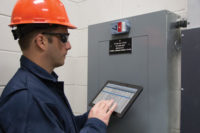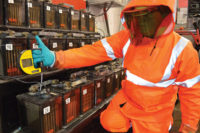An essential element for electrical safety and reducing electrical accidents is to ensure any electrical equipment is in an electrically safe condition before work begins. The National Fire Protection Association (NFPA 70E and 70B) and the Canadian Standards Association (CSA Z462 and Z463) provide references for facilities to meet the requirements of electrical workplace safety and outline the best practices for setting up and maintaining an Electrical Preventative Maintenance (EPM) program.
Most industries currently use condition-based maintenance (CBM) equipment such as infrared thermography to inspect their electrical systems. Thermography is a proven technology for detecting elevated temperatures within energized electrical distribution systems. Typically performed on an annual basis, infrared inspections can detect evidence of overheating caused by loose/deteriorated connections, overloaded circuits and imbalanced loads. These inspections can help prevent unexpected failures, but like all CBM technologies, they only provide a single “snapshot in time.” The subject systems are unmonitored for the balance of the year.
Wireless advances
Wireless sensors permanently installed on electrical enclosures can provide year-round monitoring of critical electrical system components and can immediately alert personnel when problems arise. These systems enhance the safety and effectiveness of any electrical maintenance program and offer energy savings by allowing for the timely repair of loose connections that create increased resistance, thus resulting in higher energy costs.
Engineers conducting infrared inspections are sometimes unsure of what temperatures actually constitute an alarm. To help engineers, NETA (InterNational Electrical Testing Association) has a table (Table 1) that gives recommended actions depending on the temperature difference (delta) between like for like components within a panel or the delta between the measured component temperature and ambient temperature.
Of course, when thermographers and electricians open electrical panels to perform infrared inspections per NFPA 70B and CSA Z463 guidelines and insurance requirements, they increase the risk of an arc flash trigger or electrocution. NFPA and CSA rate the removal of bolted panels on energized electrical equipment to be in the highest hazard/risk category. Consequently, NFPA 70E and CSA Z462 standards for electrical safety must be adhered to.
Electrical maintenance safety devices
Before conducting any maintenance task, you must ensure that, if possible, you eliminate any risks to the engineers or operators. Personal Protective Equipment (PPE) should always be the last line of defense. This is why many companies have adopted the use of several types of Electrical Maintenance Safety Device (EMSDs) to include thermal imaging equipment, infrared (IR) windows, ultrasound guns, ultrasound ports, on-line monitoring systems, PPE, etc.
On-line monitoring systems can be configured to collect data at specific time intervals on a daily basis. The data is wirelessly transmitted for analysis and trending and warns the operator of temperature rise within your electrical enclosures – well before more serious problems arise.
On-line monitoring of critical assets bridges the gap between annual CBM inspections by monitoring and reporting critical parameters such as the temperatures within your electrical enclosures on a daily basis. If a critical issue arises, immediate notification allows for appropriate corrective action, before costly damage occurs. System alarms warn maintenance technicians of potential issues causing the elevated internal ambient temperatures. This gives maintenance personnel an enormous safety advantage prior to any type of routine maintenance or troubleshooting of possible electrical anomalies within the electrical enclosures.
Although on-line systems notify operators that there is an elevated reading within a critical system that needs immediate attention, problems still can arise accessing the equipment to check what is causing the alarm. In the case of thermography, you do not want to shut down the equipment to open the covers for an inspection. You need the equipment loaded and on-line to see exactly what is causing the issue. This is why you should include other EMSDs such as IR Windows, ultrasound ports, etc.
A complete closed loop inspection system allows for: 1) safe inspection of electrical systems; 2) maintenance of an “enclosed and guarded condition;” and 3) protection of personnel from exposure to risks of arc flash or electrocution.
In this system design, an operator receives an alarm as well as a location from the monitoring system when the temperature differences are above a predetermined level or significantly different from other electrical enclosures within the system. Operators then go to the identified enclosure and inspect the internal energized and loaded components inside of the electrical enclosure through an infrared window in complete safety. The infrared scan allows the operator to ascertain the exact temperature and condition of the fault causing the temperature rise and, if required, to conduct the repair once the system is made safe.
Once the repair is completed, the system can be reenergized and a follow-up inspection completed to ensure everything is correct. The electrical enclosure then can be benchmarked and system reset with new baseline temperature delta.
On-line monitoring and closed loop EMSD give engineers a solid foundation to build a safe and effective electrical preventative maintenance program. Companies maintain safe working environments and maintenance programs by complying with local safety standards and practices such as NFPA and CSA. Improved electrical safety records reduce medical incident rates, workers’ compensation costs and other indirect costs of electrical accidents.



